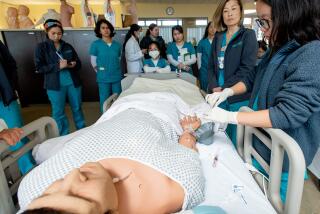A College in Search of an Academic Road Map
University officials are developing a five-pronged academic plan for Ventura County’s emerging California State University campus designed to build on the region’s assets and produce graduates fully prepared to begin their careers or move up the professional ladder.
While still in its formative stages, the plan is rooted in the disciplines of business, arts and humanities, computer science, the biological sciences and teacher preparation.
In each subject area, university planners hope to create programs that tap a wealth of regional resources and teach skills specific to local industries.
The business curriculum, for example, might include a program in international commerce that incorporates the study of trade at Port Hueneme’s deep-water harbor. It also may include a program in financial management that provides specialized accounting courses for bookkeepers at the county’s Navy bases and farming operations.
In the biological sciences, academic planners envision an environmental science program where students use the Channel Islands and other nearby marine sanctuaries as living laboratories.
At the same time, CSU officials want to develop a biotechnology program that draws on the expertise available at the county’s biomedical powerhouses--primarily Amgen Inc. and Baxter Healthcare Corp., both in Thousand Oaks--while turning out a steady stream of workers for that burgeoning industry.
Similar relationships and innovations are contemplated for studies ranging from computer engineering to teacher training, as university officials prepare to open the Channel Islands campus in August 2002.
“This kind of academic direction is central to our mission; everything follows from there,” said Handel Evans, president of the campus under development at the former Camarillo State Hospital complex.
“I think we’re sending a message to everybody that this is not going to be someplace you go when you can’t get in anywhere else,” he said. “We are inventing a university for the next millennium, one that I know the people of this area will take great pride in and want to attend.”
University officials are quick to note that the planning efforts are still embryonic and that no concrete academic foundation can be poured until at least the summer of 2000.
That is when state lawmakers will be asked to set aside $10 million for the budding campus. Some of that money will be used to hire about 20 faculty planners who will be responsible for defining the curriculum and designing programs of study for each degree.
To that end, half a dozen academic advisors--professors culled from other Cal State campuses--have been meeting since April to set the academic direction for the new university. The group is scheduled to present its first report on that issue this week to Evans and David Spence, the university system’s chief academic officer.
*
As at other colleges, Channel Islands will offer the standard range of general education courses in English, math and history.
Courses will also respond to proven need, building on the success of the Ventura campus of Cal State Northridge, which will relocate to the Channel Islands university this summer. CSUN’s off-campus center, the largest satellite facility in the Cal State University system, has built a solid program of upper-division studies focusing on child development and sociology.
But Spence said the new university will carve its own niche as the curriculum develops, setting the campus apart from others in the state university system.
“We don’t look at Channel Islands as an experimental university, as a place to try everything new we can think of,” Spence said. “But we do expect to develop programs that meet the needs of that area.”
Even though the curriculum is years away from completion, controversy already surrounds the educational program.
Some people worry that the programs will be inferior to those offered by other universities, particularly at competing University of California campuses and the county’s private colleges.
One local group, Concerned Citizens for Quality Higher Education, launched a campaign two years ago to block the new campus on the grounds that it would evolve into a “new age polytechnic” devoted to job training and advancing a liberal agenda rather than the loftier pursuits of higher learning.
*
Those concerns grew out of the curriculum developed for the state college at Monterey Bay. There, controversy swirled around programs designed to prepare students for an increasingly multicultural and diverse society through courses in community participation, culture and equity.
Stanislaus Pulle, dean of the Southern California Institute of Law at Ventura and Santa Barbara, said after learning about the curriculum at Monterey Bay, he became concerned about the quality of education at Channel Islands. He worries that the new university will offer a regimen of “soft science courses” that produces graduates with few prospects for employment.
Pulle said he recently met with a student who was unable to find work despite earning two degrees from the Cal State University system. He said the university’s curriculum should have been established before the Cal State University governing board approved creation of the Channel Islands campus.
“I think they put the cart before the horse,” he said. “The curriculum should drive the need for the university. Now it looks like it’s just an afterthought.”
University planners deny that. They say the programs under consideration are the result of months of study and surveys designed to determine local educational needs.
The Ventura County Leadership Academy--a group of educators, business leaders and other professionals--conducted an informal survey that concluded the campus should consider a mix of traditional studies and courses designed to move the county into a new technological age.
Of the 300 people surveyed, 19% favored courses in computer science, 17% wanted a strong business emphasis and 15% listed liberal arts as their top priority.
*
Similarly, a survey conducted at the Navy bases at Point Mugu and Port Hueneme found wide interest in business and computer courses.
Perhaps no group is more attuned to the developing curriculum at Channel Islands than the U.S. Navy.
Retired Navy Adm. Phil Quast, an advisor to the CSU system on new initiatives and programs, has been working for a year with university officials to find ways to help military and civilian personnel at the local bases take advantage of the new campus.
The most promising development so far is a relationship forged between the Navy Postgraduate School in Monterey and the Channel Islands university. The two schools plan to join this fall to offer a master’s degree in management sciences at the Camarillo campus.
Ultimately, Quast said he hopes the two institutions can develop a dual track allowing personnel at the local Navy bases to earn degrees either through the postgraduate school or Channel Islands university.
Quast said his goal is to help military and civilian employees sharpen their skills or advance in their careers. But he said he is equally concerned with finding ways to help retain military personnel.
“Historically, one of the knocks against Hueneme and Mugu is that once you are assigned there, there is no place to continue your education unless you drive forever,” Quast said. “We would like to make it attractive enough so that people stay for much longer than their minimum time.”
It is possible that hundreds of civilian and military personnel, and their dependents, could end up taking courses or pursuing degrees at Channel Islands. Many have expressed interest in programs such as business management and computer engineering.
There is also growing interest in a developing program to help local Navy employees enter the teaching profession.
*
Courses will primarily be taught through distance-learning technologies, such as the Internet and interactive television, and will be broadcast to a studio classroom at the campus from Cal State Northridge.
Participants will be able to work toward secondary teaching credentials, which are necessary to teach middle school or high school.
Other teacher-preparation initiatives include a program allowing prospective teachers to start working toward their credentials as early as freshman year.
Currently, prospective teachers first earn a bachelor’s degree, then take an additional year to earn their credentials through a combination of course work and on-the-job training.
“Channel Islands is building its program from the bottom up; they are going to be able to create a state-of-the-art teacher preparation program,” said Charles Weis, superintendent of the county schools system.
“They are creating new ways to do the business of higher education,” he said. “They are creating new partnerships, asking the right questions and building something that is going to be unique and a model for how things are done.”
University planners caution that there is plenty of work ahead.
Barbara Thorpe, who heads academic planning for the Channel Islands campus, said she will continue to lay the groundwork for potential programs in anticipation of the day the university gets the green light to hire planning faculty. University officials say they receive as many as a half-dozen inquiries a day from educators interested in working at the new campus.
Thorpe said even if the $10 million is approved for Channel Islands in the summer of 2000, it will still take months to hire the initial faculty to create the academic plan. That makes for a tight deadline, considering the university is set to open in fall 2002. But she said she is confident it can be done given the work that already has taken place.
“There is nothing more important to the success of this university than a relevant, forward-thinking academic program,” Thorpe said. “It’s what drives everything else we are trying to accomplish.”
(BEGIN TEXT OF INFOBOX / INFOGRAPHIC)
Creating A College Campus
Cal State Channel Islands is set to welcome its first class of students in August 2002, ending Ventura County’s decades-long wait for a public university. Here are some fast facts about the campus under development at the former Camarillo State Hospital complex:
Anticipated enrollment
when the campus opens in 2002: 3,600 students; when the freshman class of 2002 graduates four years later: 4,480 students; a decade after the university opens: 8,265 students
*
Anticipated budget
for fiscal year 2001-01: $10 million; for campus expansion in 2004-05: $20 million
*
Core Academic Program:
* Teacher Education/Preparation
* Arts and humanities
* Computer Sciences (includes communication technology and computer engineering)
* Business (includes business management, public administration and agricultural production)
* Life and biological sciences (includes biotechnology, marine and environmental sciences and professional health services)
*
Cal State campus first authorized for Ventura County: 1962
Cal State campus approved for Ventura County: September, 1998
Channel Islands officially adopted in the CSU system: May, 1999
Campus acreage: 630 acres
University mascot: Dolphin
About This Series
With a public university set to open in Ventura County in August 2002, California State University officials are starting to develop academic programs for the new campus. “Birth of a University: Countdown to a Cal State Campus” is an occasional series chronicling the creation of the Channel Islands campus at the former Camarillo State Hospital complex. This installment examines the emerging curriculum, which focuses on such disciplines as business, computer science and teacher preparation.
More to Read
Sign up for Essential California
The most important California stories and recommendations in your inbox every morning.
You may occasionally receive promotional content from the Los Angeles Times.









